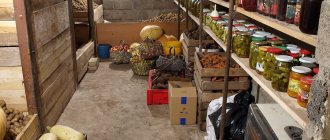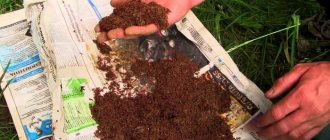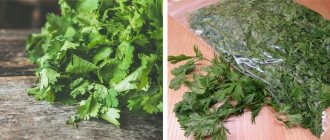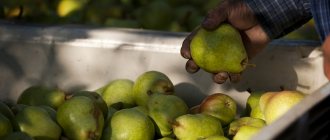Choosing broccoli for storage
Like most vegetables, broccoli comes in varieties with different ripening times. When preparing to grow, in the spring it is important to decide whether you want to grow broccoli for winter storage or not. If the purpose of planting is to eat cabbage in the summer, then early ripening varieties are suitable. If you want to cook dishes from it in winter, there are mid-season or late-season varieties for this. The difference is that the inflorescence heads of later varieties are denser and heavier. The slower and longer the head of cabbage ripens, the more nutrients it accumulates, and the longer it can be stored.
The next thing to know is that not every fork of broccoli is suitable for storage. Choose heads no more than 20 cm in diameter, and preferably 12-15 cm. The color should match the color of the variety, while having a uniform, rich shade. Pay attention to the inflorescences. They should be closed and located close to each other. The buds along the edge of the fork should be small, towards the center their size increases
Feel free to throw away the loose, yellowed head with blossoming or half-blown inflorescences. Broccoli that begins to bloom cannot not only be stored, but also eaten. There are no nutrients left in it.
Remember: upon external inspection, the heads of cabbage should also not have any stains or dents. Damaged broccoli cannot be stored. It will rot quickly.
Frozen gifts of the fields
Try storing broccoli frozen for the winter. Experienced housewives claim that when properly frozen, the crop retains its excellent appearance and maximum nutrients.
Find out how to store other types of cabbage at home in winter: white cabbage, cauliflower, Peking cabbage, kohlrabi.
Let's start with preparation
To freeze broccoli for the winter, you need to prepare it properly. Select strong, healthy green heads with a diameter of 8-15 cm. Cut off the stalk, remove the leaves, and disassemble the cabbage itself into single inflorescences.
Before freezing, do not forget to get rid of any insects that may remain between the flowers. For this:
- Fill a basin or bowl with water, add 40-45 g of salt per 1 liter of water.
- Lower the inflorescences, leave for 20-25 minutes, then remove and rinse thoroughly.
- Drain in a colander to drain excess moisture.
The stem of the plant contains the lion's share of nutrients. It can be successfully eaten by first cleaning the top layer
Freezing without blanching
You can freeze broccoli for the winter without blanching:
- First, rinse and place on a napkin to dry.
- Then pack into bags and freeze.
Some housewives complain that after defrosting, cabbage changes color and becomes soft. Yes, it will not be as elastic as before, but the color will remain. To prevent the inflorescences from becoming soft, it is recommended to freeze them using a different recipe.
First we blanch
To freeze broccoli for the winter and maintain its elasticity, you must first blanch it.
- Prepare 2 pans. Place one on the fire, adding 1 tsp. citric acid per 1 liter of water, fill the second with cold water and ice.
- Place broccoli in boiling water in portions and blanch for 1-2 minutes. Then immediately cool them in ice water to stop the heating processes.
- Place the inflorescences on a napkin or towel and allow excess liquid to drain. To ensure that the frozen product retains its nutritional value, it must be completely cooled.
- Pack the semi-finished product in plastic bags and place in the freezer. Freezing will keep it fresh for the next 8-10 months.
Tip of the day
There are varieties that, with or without blanching, after defrosting, are only suitable for pureed soup. If you don’t know how your particular cabbage will behave, put a small piece in the freezer for 24 hours. During this time, nothing will happen to the entire batch, and after defrosting the “sample”, you will know what it is good for.
And finally, a video from which you will learn how to cook broccoli to preserve all the vitamins:
Now you know everything about proper freezing and other storage options for broccoli. And with the onset of winter cold, you can easily prepare a lot of delicious dishes, giving your body the vitamins that cabbage contains.
Store correctly and be healthy!
Useful materials:
- Broccoli is a cauliflower Cauliflower is an annual plant. The inflorescences are white, may have a slightly yellowish tint, and occasionally...
- How long do potatoes last in the refrigerator? How to store potatoes Raw potatoes - 3 months For storage at room temperature, it is important to pour potatoes...
- Cabbage with apples With the arrival of autumn, every housewife tries to prepare sauerkraut and everyone has a recipe for its preparation...
- Growing broccoli Broccoli is also called asparagus cabbage, and, in fact, it is a variety familiar to all of us...
When to Harvest
Broccoli should be cut for storage as late as possible, but it is important not to allow it to become overripe. It is better to choose a cool and cloudy day, or go out into the garden to collect early in the morning or late in the evening. Do not wait for frost, otherwise the entire harvest will be lost.
When cutting, leave a stem about 15 cm long. If the day is warm, do not leave the cabbage heads lying in the open air. Take them immediately to the cold, because broccoli loses its taste very quickly and loses its elasticity. Literally after half an hour of “rest” in the shade, 30% of the nutrients are lost.
How to store fresh broccoli
Hand-cut broccoli heads should be put into the refrigerator as soon as possible.
If cabbage is purchased at the market, it should be green (less often purple). The heads should be dense, all buds should be closed. There should be no dark spots or mechanical damage on the heads. The petiole cut should not be rotten.
Broccoli cannot be stored for long periods of time, like white cabbage. Even in the refrigerator, it can be kept for no more than 10 days without loss of taste. And only if all storage rules are followed.
Method 1
- For storage, select only dense heads without signs of damage or dirt. Do not wash cabbage before putting it in the refrigerator!
- Trim off any protruding part of the stem.
- Take a plastic bag and make several small holes in it for free air circulation.
- Place only one head in each bag.
- Without closing the bag, put it in the refrigerator in the vegetable compartment. Fruits and vegetables that emit ethylene should not be located near cabbage, otherwise the cabbage inflorescences will begin to actively bloom and the broccoli will turn yellow.
Note : Broccoli can be stored in a bag for about a week. You should not leave it for a longer period, because the taste of the cabbage will become much worse.
Method 2
- Prepare a small container whose diameter is slightly larger than the diameter of the broccoli head. Pour 1.5–2 cm of water into it.
- Place the prepared head, petiole down, in this makeshift vase. Cover the structure with a clean plastic bag, making small holes in it to allow air circulation. Place the container of broccoli in the refrigerator. If you change the water daily, the broccoli will stay fresh for several days.
How long does broccoli last?
The duration of storage of broccoli depends on the temperature and humidity. The lower the temperature, the longer the cabbage is stored:
- in the refrigerator, at a temperature of 4°C to 7°C – no more than 3 weeks;
- in the cellar, where the temperature remains stable from 0°C to 3°C - up to two months;
- frozen (minus 18°) – from 6 to 8 months.
If you decide to store in the refrigerator or cellar, then keep in mind that the air humidity should be at least 90%.
Alternative methods (drying, pickling, in the basement)
Drying broccoli
If you don't have enough room in your refrigerator or freezer to store whole or chopped broccoli, you can dry the broccoli. In this case, the vegetable will lose a significant part of its mass, but will retain many useful properties. Subsequently, dried fruits are added to first courses, as well as side dishes and casseroles. The forks are first blanched for a couple of minutes, then split into inflorescences, and then heat-treated in an oven or electric dryer.
In the cellar
Cabbage can be kept underground if the conditions are met: the room is ventilated, cool, dark and humid. To store broccoli, wrap it in paper. It is necessary to periodically monitor stocks for rot and replace damp paper. The vegetable will last a maximum of a month in the cellar or basement.
Pickling
When pickled, broccoli can live for about 4-5 months. This is a great option for a snack. You will need a couple of chili pods, two kilos of cabbage, a bay leaf, 10 peppercorns, three glasses of vinegar and a glass of sugar. You also cannot do without two tablespoons of salt and five glasses of water.
Everything is mixed and brought to a boil. At the same time, the cabbage is cleaned, divided into inflorescences and blanched for a couple of minutes in the resulting solution, then placed in jars, filled with marinade, to which chopped chili is added. The workpiece is twisted or sealed and stored until required.
Previous Vegetables and mushroomsDried garlic and homemade garlic seasoning
Broccoli, a competitor to cauliflower, is becoming more popular every year. The secret is in the nutritional composition of the vegetable, rich in phosphorus, calcium, magnesium, vitamins A, C, E, PP, group B. The green and purple heads contain vegetable protein and amino acids, essential for children and those on a diet. In order for the vegetable to last as long as possible, you need to know how to store broccoli at home. Anyone can cope with the task, just know the simple rules and listen to the recommendations.
Preparing broccoli for storage
Once you decide where you'll store your broccoli, be sure to get your forks ready.
When freezing, the forks are washed and dried. If it is stored at positive temperatures, then under no circumstances should it be washed.
When harvesting, you need to make sure that the forks do not get dirty with soil or sand. If this does happen, clean them from dirt with a soft brush. Do not press or rub. Damage to cabbage leads to rapid spoilage and reduced shelf life.
Other harvesting methods
We'll tell you how to pickle broccoli using a classic recipe as an example. The preparation will require the following ingredients:
- broccoli inflorescences - 400 g;
- carrots - 2 pcs.;
- garlic - 6 cloves;
- fresh dill - several sprigs;
- bay leaf - 2 pcs.;
- black peppercorns - 15 pcs.;
- sugar - 10 tbsp. l.;
- salt - 4 tbsp. l.;
- water - 1 l;
- Sunflower oil - 200 g;
- vinegar 9% - 1 tbsp.
Preparing the snack is not particularly difficult. If you know how to prepare white cabbage, then you can easily cope with this recipe.
How to pickle broccoli:
- The forks are divided into inflorescences, washed and dried. Carrots are cut into rings or cubes. Garlic is passed through a press. Dill is chopped.
- Vegetables and herbs are mixed in one container and then placed in sterilized jars.
- To prepare the marinade, boil water. Sugar, salt, vegetable oil, bay leaf and pepper are added to it. Boil for 10 minutes, add vinegar and remove from heat.
- Pour the hot marinade over the vegetable mixture. The jars are rolled up and left for 2 days in a dark place at room temperature. Then they are stored in the refrigerator.
At home, a fresh vegetable at room temperature retains its freshness for no more than 3 days. In the refrigerator, in the vegetable compartment - about 15 days. For longer storage, in addition to pickling, broccoli is pickled, fermented, dried and frozen.
For salting, the head of cabbage is cut into inflorescences, washed and dried. Place in a clean 2-liter jar and fill with cold water. Add 25 g of salt and put it in a dark place at room temperature. The cabbage is infused until the fermentation process begins. The fermented liquid is drained. Add 40 g of sugar, mix and pour back. The jars are again put away in a dark, warm place for 3 days. After 3 days they are stored in the refrigerator.
Fermenting broccoli
To prepare this snack you will need the following ingredients:
- broccoli - 1 kg;
- salt - 40 g;
- vinegar 9% - 40 g;
- water - 0.5 l.
Cooking method:
- The head of cabbage is cleaned of impurities, cut into inflorescences and washed. The inflorescences are placed in a container for fermentation.
- Prepare the brine: add salt to hot water and vinegar. Bring to a boil, remove from heat and cool.
- The cabbage is poured with brine and left for 2 weeks at room temperature.
- Then the brine is poured into a container and boiled.
- The cabbage is placed in sterilized jars and filled with brine. Sterilize for 15 minutes and close. The fermented product is stored in a cellar or basement.
Drying broccoli
To dry cabbage, it is cut into inflorescences, washed and dried. The stems of the inflorescences are cut off, leaving a length of no more than 2 cm. Blanch the cabbage in boiling water for 3-5 minutes, remove it and place it in a colander to drain all the liquid. Then place on paper towels and dry.
Place the prepared cabbage on a baking sheet and place in the oven. The oven temperature is set to 60°C. The door is left ajar during drying to allow excess moisture to escape. To ensure uniform drying, the product is stirred periodically. Dry the inflorescences until completely dry.
The dried product is stored in a dark place in paper bags. It is soaked before cooking.
Freezing
A properly frozen product retains all micro- and macroelements and up to 90% of vitamins.
Before freezing, the cabbage is washed, the stem is cut off, and cut into inflorescences. Then they are immersed in a saline solution. After half an hour, take it out and wash it with cold water and dry it.
Boil water, add cabbage to it and cook for 3 minutes. Place in a colander and cool under running cold water. Let the water drain. After this, place the broccoli on paper towels and dry thoroughly.
To freeze cabbage, lay it out on a tray or cutting board and place it in the freezer. After 3-4 hours, the tray is taken out, the frozen product is laid out in plastic bags or plastic containers. The container is marked with the name of the product and the date of freezing in order to navigate the frozen products and monitor the expiration date. The frozen container is placed in the freezer for long-term storage.
Method for storing broccoli in the basement
For storage in the basement, three things must be observed:
- temperature from 0° to 3°;
- high humidity;
- good ventilation.
Plastic boxes with holes are best for storing broccoli. Their bottom should be covered with a damp cloth. Place the cabbage heads with the stem on the cloth. Try to keep the forks touching each other as little as possible.
How to freeze: rules
How to properly freeze broccoli:
- For storage, use special freezer bags or plastic containers with lids. The material must be resistant to low temperatures and strong enough.
- Place cabbage in bags only in dry form.
- Distribute everything in portions so that you can use one piece at a time. Repeated freezing is harmful to any product, try to avoid this.
- You can first freeze the inflorescences and then put them in bags. This way they will definitely not stick to each other.
- The standard storage temperature is 18 degrees below zero. If possible, set the indicators below.
- The shelf life is 8-12 months, but it is better to eat the product quickly.
- Broccoli can be prepared as part of a vegetable mixture or with herbs. To do this, simply chop it finely.
We recommend: How to quickly and correctly peel a pomegranate – several effective and affordable methods
Tip: In case of large volumes, attach stickers to bags and containers with the date the product was placed in the freezer. This way you won't forget to use everything before the expiration date.
How to Store Broccoli Heads in the Refrigerator
The easiest way to keep broccoli fresh in the refrigerator is to place the cabbage in a plastic bag with several holes in it for ventilation.
Another good way is to place cabbage forks in a container of water. You only need a little bit of water, no more than one centimeter. Check to see if you can leave open containers with liquid in your refrigerator. If excessive evaporation of water can damage household appliances, then do this:
- choose a wide bowl and pour in some water;
- stretch cling film over it;
- make a small hole the size of the stalk;
- insert the forks into this hole so that the edge of the leg is in the water.
In a refrigerator
Fresh vegetables contain more vitamins than frozen ones. Therefore, the question of how to store fresh broccoli for as long as possible is always relevant. Optimal conditions for this type of cabbage are humidity 90-95%, temperature 0-10˚C. In this “climate” it will be fresh within one to two weeks.
The conditions necessary for broccoli can only be created in the refrigerator. Store it in the vegetable compartment.
Do not place broccoli together with tomatoes, apples, carrots and other products that emit ethylene, as they speed up its spoilage.
Since this vegetable is quite capricious, so that its reserves do not disappear, you need to know how to store broccoli in the refrigerator correctly. We offer you several ways:
- Pour cold water into the container to a level of 1-2 cm from the bottom. Place the cabbage in a container so that the inflorescences rise above the water. Cover the broccoli with cellophane with holes and place it in the refrigerator. Change the water every day. This way you will extend the freshness of the vegetable for 5-9 days.
- Spray the cabbage with water from a spray bottle, wrap loosely in paper towels and store in the refrigerator. This way it will not wither within 3-4 days.
- Separate the broccoli head into florets. Place each in a separate bag with holes and put it in the refrigerator. The shelf life of broccoli in polyethylene is 2-3 days.
It is not recommended to wash the vegetable before placing it in the refrigerator, as excessive moisture can speed up the process of rotting. If there is an urgent need to wash the cabbage, then dry it well before putting it in the refrigerator. To prevent broccoli from losing its taste during storage, disassemble the head into florets immediately before use.
Useful tips
If you want to serve broccoli dishes all year round, it's easy to do:
- Plant several varieties with different ripening periods. Then already in the middle of summer it will be possible to cut the first harvest. Late broccoli will keep well if you follow our tips.
- When you harvest your last harvest, divide it into three parts. Put the first, small one in the refrigerator and eat it first. Place the second part in the cellar. And when you use it up, it will be the turn of frozen broccoli, which will not lose its quality until late spring.
If you are already an experienced gardener, then I would like to hear how you store broccoli. Do you have any proven methods you could share?
Choosing a broccoli variety for long-term storage
Like any other garden crops, broccoli comes in varieties with different ripening periods. Before sowing the seeds, you need to decide on the choice of cabbage seeds. This will determine when the vegetable ripens and whether it is suitable for winter storage. The fact is that early varieties of broccoli have loose heads that quickly fade.
Mid-season and late hybrids have the best shelf life indicators. They are more resistant to temperature changes and diseases, they can easily tolerate dry periods, which means that such vegetables are able to stay fresh longer.
The best varieties of broccoli for long-term storage:
Selecting, Preparing and Freezing Broccoli
Like other varieties of cabbage, broccoli can be frozen. This is the best way to store vegetables in winter. When frozen, broccoli retains almost all its beneficial properties.
Young and green inflorescences are best suited for freezing.
IMPORTANT: Be sure to choose firm, healthy vegetables without rot, yellow spots and pest damage
First way
The first method is freezing without heat treatment.
Before freezing, you need to prepare the fruits:
- Immerse the inflorescences for 30-40 minutes in a salty solution (1 teaspoon of salt per 1 liter of water);
- Divide the head of cabbage into small florets of approximately the same size and remove the leaves;
- Rinse with cold running water to remove any remaining salt;
- Dry the inflorescences on a flat surface, spreading them on cotton cloth or paper towels.
- It is not recommended to use newspapers and other types of paper that contain paint.
- Place the dried vegetables on a flat surface (you can use a tray) and freeze;
- Place the frozen inflorescences in small portions in special bags for freezing;
- Remove as much air as possible from the bag and place back in the freezer.
Freeze:
Advantages of this type of freezing:
- The taste and color of the vegetable does not change;
- All beneficial properties are preserved.
Disadvantages of this type of freezing:
Some types of microorganisms may survive.
Second way
This method differs from the first only in that the inflorescences are amenable to heat treatment.
Preparation steps:
- We adhere to the first three points from the previous method;
- Immerse the inflorescences in boiling water for a couple of minutes, after adding citric acid (0.5 tsp per 1 liter of water);
- Take out the broccoli and immediately plunge it into ice water to keep it crisp (you can use a colander);
- See points 5,6,7 from the previous method.
Is it possible to freeze cabbage:
Advantages
This type of freezing is that all microorganisms that can multiply even in frozen vegetables are destroyed.
Flaw
This type of freezing means that the beneficial properties of broccoli are partially lost.
For a child
If you want to freeze broccoli for a child, it is best to use the second freezing method.
. Baby food requires a more careful approach, especially if the vegetable was purchased and not grown by you yourself.
When is broccoli harvested?
The main rule that gardeners follow when determining the harvest date is that the heads are cut off as late as possible, but they should not bloom. Overripe broccoli loses most of its nutrients and flavor.
Cabbage is harvested until frost, when the size of the inflorescences exceeds 10 cm in diameter. At the same time, bright green buds should be dense and elastic. Broccoli is harvested early in the morning in dry weather. The heads are carefully cut off with a sharp knife, cutting them off along with a fragment of shoots up to 12 cm long.
Attention! Immediately after harvesting the cabbage inflorescences, the broccoli is transferred to a cool place.
Not all heads can be sent for storage. Having collected the inflorescences, they are inspected and sorted. The forks with open buds are put aside and these are eaten in the near future. Dense, elastic heads with a uniform green color, 12–15 cm in diameter, are the best specimens; these are the ones you will work with.
Broccoli harvest
Description and characteristics of broccoli
Broccoli, also known as cabbage, is an annual vegetable plant classified in the Brassica family. It is a type of garden cabbage.
Its stem grows 60–90 cm in height. At its top many peduncles with small green buds are formed, which are collected in a loose head. Broccoli intended for eating is cut when the buds have not yet opened. Cabbage with overripe yellow buds is unsuitable for food.
Broccoli is valued because of the many valuable properties that it has on the human body when consumed.
- Among them:
- replenishment of important vitamins (A, beta carotene, groups B, C, E, K, PP) and minerals (potassium, calcium, magnesium, sodium, phosphorus, iron, manganese, copper, selenium, zinc);
- removal of salts, toxins and heavy metals from the body;
- prevention of the development of cardiovascular and cancer diseases;
- normalization of cholesterol and insulin levels;
- promoting the formation of new tissues.
The vegetable has a low calorie content - only 34 kcal/100 g. Thanks to this number of kilocalories, it is classified as a product with a negative calorie content, since more energy is spent on its digestion than is obtained from its consumption.
Top articles: Rolling garlic for the winter
Did you know? US resident John Evans, whose hobby is growing giant vegetables, managed to grow huge heads of different types of cabbage and set several records. His white cabbage weighed 34.4 kg, Brussels sprouts - 14.1 kg, broccoli - 15.8 kg.
Terms and optimal conditions for storing vegetables
Broccoli spoils quickly at elevated temperatures. Immediately after cutting, the prepared forks should be placed in a cool room with high humidity and good ventilation. Shelf life directly depends on the thermometer readings:
- at a temperature of +5…+7 ºС the vegetable can last for 5–8 days;
- if the mercury level is lower and fluctuates between +1...+3 ºС, the heads will retain their original appearance and taste for 1–1.5 months;
- Frozen forks can be stored for six months.
Freezing for long-term storage
To keep broccoli fresh until the next harvest, it is better to freeze the vegetable. For this purpose, late-ripening varieties that have a dense structure and bright green color are used. For long-term storage, vegetables with a large central inflorescence are used. There should be no brown colors or any damage on its surface. Spoiled vegetables are not suitable for long-term storage. It is better to buy cabbage during the natural ripening season. Between August and September.
Freezing broccoli is a lengthy but not labor-intensive process that does not require skill or special skills. The housewife should simply carry out the processes according to the given algorithm:
- Vegetables are cleaned of soil and dust and must be washed under running water. This is an important point because broccoli must be cooked immediately after being removed from the freezer.
- To get rid of various insects that may be in the inflorescences, the cabbage is soaked in a saline solution for 30-60 minutes. The parasites will die and float to the surface.
- Broccoli is washed again and the leaves are removed.
- The vegetable is divided into inflorescences so that their diameter does not exceed 2-3 cm. If the central shoot is too large, it is cut into several parts.
- The trunk is cut into small pieces, and the hard part of the stem is thrown away.
Helpful advice! To ensure that the bright green color is preserved after freezing, before freezing, the cabbage must be soaked in a solution of citric acid or lemon juice for 5-7 minutes.
The mass of cabbage required for one-time use should be calculated and the product packaged in separate bags. Broccoli, like many other vegetables, does not tolerate re-freezing and loses its color and shape after thawing. The packages need to be marked; the note should indicate the date of freezing and weight, as well as the method of preliminary heat treatment.
With pre-heat treatment
Before freezing, cabbage must be subjected to heat treatment. The vegetable is blanched or steamed until half cooked. When exposed to heat, enzymes in broccoli are destroyed that can lead to spoilage of the product, so processed cabbage is stored in the freezer longer.
The work is carried out according to the following algorithm:
- the prepared cabbage is placed in a colander and immersed in boiling water for 5-10 seconds;
- the process is repeated 3 times;
- lay the vegetable on a clean towel and wait until it dries completely;
- Packed in bags in the required volume and placed in the freezer.
The duration of cooking in a double boiler is 10 minutes, during which time the half-cooked state will be reached.
No heat treatment
You should not freeze broccoli without first blanching it. If they remain in the freezer for a long time, the cabbage inflorescences will turn into dust and completely lose their structure. You should not worry too much about the fact that the vegetable will lose its taste; heat treatment enhances it.
For use in baby food
If you plan to use broccoli as a baby food product, it should be frozen as a puree. The preparation is made according to the following algorithm:
- the product is separated into individual inflorescences;
- rinse well under running water;
- place a pan of drinking water on the stove and add a little salt;
- after boiling, lower the inflorescences and cook them over low heat under a closed lid for about 15 minutes;
- puree using a blender;
- laid out in pre-prepared sterile containers and sent to the freezer.
The product prepared according to this recipe should be kept in the freezer for no more than 4 months. After thawing, the product should not be re-frozen.
How to preserve broccoli longer
Cabbage cannot stay fresh for long at room temperature, but there are a few simple ways to preserve the elasticity of the inflorescences in the refrigerator.
In a refrigerator
The easiest option is to simply put the cabbage in the vegetable section. A stable low temperature in the chamber will preserve the vegetable for 5–7 days.
Reference! It is extremely important to consider the “neighborhood” with other products. Thus, apples, tomatoes and carrots emit ethylene, which negatively affects the condition of broccoli.
To preserve cabbage longer, use one of the popular methods.
In a container of water
One of the simplest options is to make an impromptu bouquet of cabbage. Partially submerged in water, the vegetable will remain fresh for up to 9 days:
- Pour a little water into a container of suitable size (up to a 2 cm layer).
- Broccoli is placed so that the inflorescences are on the outside.
- The fork is covered with a thick plastic bag, in which several holes are made for ventilation.
In this state, the product is sent to the refrigerator. The water is changed every day.
In a paper towel
The second option involves wrapping the fork in a thick paper napkin or towel. This method is simpler, but the shelf life of the product is no more than 4 days:
- The inflorescences are lightly sprayed with water from a spray bottle.
- Each fork is wrapped in a paper towel so that it absorbs excess moisture.
- It is important that the napkin does not fit tightly to the inflorescences, otherwise ventilation will be disrupted.
The broccoli wrapped in a napkin is placed in the refrigerator and checked periodically. The first to be consumed are those inflorescences that show signs of spoilage or wilting.
In a plastic bag
If you need to save broccoli for 3 days, but there is no time to constantly monitor the inflorescences, use this option:
- Take bags made of thick cellophane and make several holes in them for ventilation.
- Place one fork in each bag. Tie the packaging tightly and put it in the refrigerator.
This method is not suitable for long-term storage, since condensation gradually accumulates in the bag, despite the presence of holes. This leads to rapid rotting of the product.
How to keep broccoli fresh for the winter
The freezer is suitable for this. Frozen vegetables retain all their taste and beneficial properties for up to 1 year.
Attention! Before planting, the inflorescences are blanched for 2-3 minutes in boiling water. This inhibits oxidative enzymes and destroys most pathogenic microorganisms.
To properly freeze broccoli, follow these instructions:
- The heads are washed, the stems and leaves are removed, and the forks are divided into several parts.
- The pieces are placed in a saline solution for 30 minutes and then washed under running water.
- Place the broccoli in boiling water, cook for 3 minutes and drain in a colander. When the moisture has drained, the vegetable is immediately placed in a bowl of ice water for 5 minutes.
- The inflorescences are again placed in a colander. When excess moisture has drained, dry on a paper or cloth towel.
- Completely dry heads are laid out in a single layer on a large plate or tray and placed in the freezer. It is better to turn on the fast freezing mode, if there is one, so that the product sets instantly.
Frozen cabbage is portioned into bags or containers and sent to the freezer. Repeated freezing of broccoli is unacceptable.
In the cellar
A cool and dry cellar is suitable for storing broccoli for the winter.
Attention! The basement maintains a stable temperature (0...+10°C) and humidity 90–95%. At low humidity, the forks will begin to dry out, and at high humidity, they will bloom.
To successfully preserve cabbage until the next harvest, follow these rules:
- All outer leaves are removed from the heads.
- Vegetables are placed in wooden boxes, baskets or simply on shelves. It is important that they have holes for ventilation. The bottom must be lined with fabric.
- The forks are laid out so that they do not touch each other. It is advisable to wrap each head with thick paper and change it as it gets wet.
When storing vegetables in the basement, they are periodically inspected and damaged ones are removed, since one rotten specimen will cause damage to the rest.
This is interesting:
Alternative storage methods
In addition to the above methods, to store broccoli fresh or frozen, it can also be dried and pickled.
Drying
Drying should be done in a special dryer or oven. This method allows, just like freezing, to preserve the maximum amount of valuable substances in the vegetable. You can dry cabbage either whole (if it is small) or cut into pieces.
The easiest way to dry is in a dryer. The cabbage needs to be washed, dried and cut, placed in a tray in one layer and set the required time for drying the vegetables (6-8 hours) and the temperature +45...+80°C.
Did you know? There is no broccoli that grows in the wild: this cabbage was created through hybridization. It is known that it was cultivated back in the 6th–5th centuries BC. e. in the Mediterranean.
The oven drying technology is as follows:
- Divide the head into inflorescences.
- Wash and soak in saline solution.
- Blanch - place in boiling water for 3-5 minutes.
- Dry for an hour.
- Preheat the oven to a temperature of +50…+100°C.
- Place the cabbage on a baking sheet.
- Place in a preheated oven for 3–5 hours, at regular intervals (once every 30 minutes), checking the readiness of the product and turning it over. The door does not need to be closed completely. If the oven supports convection mode, it should be activated.
Pickling
Broccoli can also be preserved by pickling. The advantages of this method are that the product can be preserved for a long time, and it also has a piquant taste. By adding various ingredients and spices, you can get a product with a completely different taste, which can later be used as an independent dish or as one of the ingredients, for example, in salads. The disadvantages of the method are the loss of a large amount of valuable substances.











